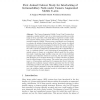Free Online Productivity Tools
i2Speak
i2Symbol
i2OCR
iTex2Img
iWeb2Print
iWeb2Shot
i2Type
iPdf2Split
iPdf2Merge
i2Bopomofo
i2Arabic
i2Style
i2Image
i2PDF
iLatex2Rtf
Sci2ools
IPCAI
2010
2010
First Animal Cadaver Study for Interlocking of Intramedullary Nails under Camera Augmented Mobile C-arm
The Camera Augmented Mobile C-arm (CamC) system that augments a regular mobile C-arm by a video camera provides an overlay image of X-ray and video. This technology is expected to reduce radiation exposure during surgery without introducing major changes to the standard surgical workflow. Whereas many experiments were conducted to evaluate the technical characteristics of the CamC system, its clinical performance has not been investigated in detail. In this work, a workflow based method is proposed and applied to evaluate the clinical impact of the CamC system by comparing its performance with a conventional system, i.e. standard mobile C-arm. Interlocking of intramedullary nails on animal cadaver is chosen as a simulated clinical model for the evaluation study. Analyzing single workflow steps not only reveals individual strengths and weaknesses related to each step, but also allows surgeons and developers to be involved intuitively to evaluate and have an insight into the clinical imp...
| Added | 05 Mar 2011 |
| Updated | 05 Mar 2011 |
| Type | Journal |
| Year | 2010 |
| Where | IPCAI |
| Authors | Lejing Wang, Jürgen Landes, Simon Weidert, Tobias Blum, Anna von der Heide, Ekkehard Euler, Nassir Navab |
Comments (0)

